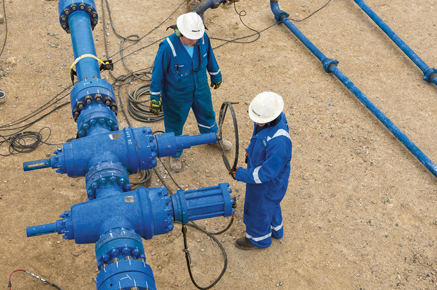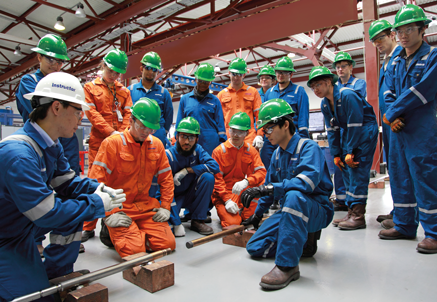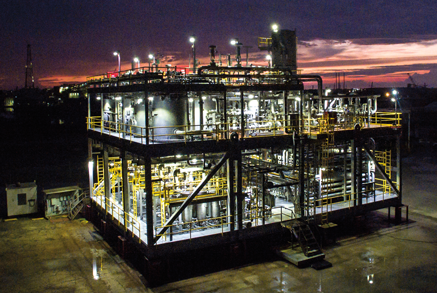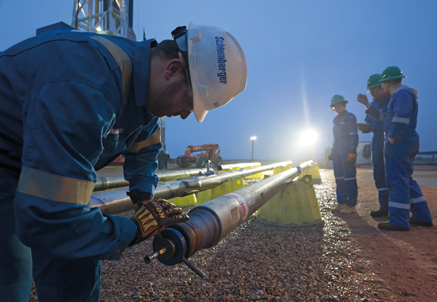Letter to Shareholders
In 2017, Schlumberger celebrated the 90th anniversary of the first well logging survey, which took place in the Pechelbronn oil field in France in September 1927. This log established the science of subsurface metrology and provided the impetus for the business venture that eventually became Schlumberger.
Schlumberger full-year 2017 revenue of $30.4 billion increased 9% year on year. This reflects a full year of activity from the acquired Cameron businesses compared with only three quarters of activity in 2016. In addition to the impact of Cameron, revenue growth was driven by unconventional land resource developments in North America due to the recovery in activity combined with market share gains and improved pricing as the oil and gas industry began to emerge from the longest and deepest downturn in 30 years.
Following two successive years of E&P investment cuts, operators increased their upstream spend in North America by more than 30% in 2017. The increase in oil price afforded by the OPEC agreement gave US producers a means to increase their investment in tight oil. However, apprehension related to growing US supply, and uncertainty surrounding the duration of OPEC- and Russia-led production cuts held international spending to a level 3% below 2016.
During 2017, the outlook improved for international markets, evidenced by a significant increase in the sanctioning of new projects. The number of final investment decisions tripled in 2017 compared with 2016, with 75% of the new projects planned for shallow and deepwater offshore environments.

After starting the year at $55 per barrel, Brent prices fell to $44 in June and then recovered to $67 by the end of the year. The price increase resulted from 2017 demand growth of 1.5 million barrels per day and strong adherence to a production agreement between OPEC and Russia, which served to reduce oil production by an average of 1.6 million barrels per day compared with the fourth quarter of 2016. Strong demand and restricted supply accelerated the depletion of stocks as the year progressed. By September, OECD crude and product stocks had returned to 2015 levels.
As the oil market began to rebalance in 2017, replacement of conventional oil reserves remained a challenge. In 2017, discoveries were at an all-time low due to lower exploration activity, and more than 60% of discovered resources were gas. Oil discoveries accounted for only 3.4 billion barrels—while about 30 billion barrels of conventional oil is produced each year—representing a reserves replacement ratio of only 11%.
In the natural gas markets, low Henry Hub prices and flat domestic consumption allowed the US to transition from importer to exporter of natural gas for the first time since 1957, and Liquefied Natural Gas was the enabler. Global LNG trading increased 11% year on year driven by demand in Asia. LNG supply growth was also strong, with the addition of six new liquefaction trains in 2017. In today’s well-supplied market, both producers and consumers are reluctant to invest in new projects. While the short-term market outlook remains challenged, strong longer-term demand growth signals a future need for new LNG supply capacity.
Schlumberger financial performance in 2017 was driven by land activity in North America, where revenue increased over 80% in line with the average rig count increase.
Schlumberger financial performance in 2017 was driven by land activity in North America, where revenue increased over 80% in line with the average rig count increase. Continued expansion of the Schlumberger hydraulic fracturing presence in North America resulted in additional fleet redeployments, which benefited the Production Group. Drilling Group revenue in North America land increased due to the continuing high demand for longer horizontal lateral sections in shale oil wells. Increased Cameron Surface and Drilling Systems product sales and services also contributed to the strong financial performance in North America. North America revenue, including offshore, grew 42% year on year.
International revenue decreased 2% compared with 2016. This decline was driven by soft demand for exploration- and development-related products and services as E&P budgets remained tight. Activity in Latin America decreased due to the Schlumberger decision to align operations with cash collections in Venezuela. Robust activity in the Middle East and Russia, driven by integrated drilling and production projects, as well as an additional quarter of activity from the acquired Cameron businesses partially offset these decreases.
During the past three years of unprecedented market downturn, Schlumberger has proactively sought to strengthen its technology offering and presence in key markets around the world. The most recent example is the expansion of its hydraulic fracturing presence in North America land through the purchase of the US fracturing and pumpdown perforating businesses from Weatherford. In line with the challenging business environment, over the same period Schlumberger has restructured all relevant parts of the company in terms of both size and organizational structure to maximize its market competitiveness and operational agility.
With the significant changes seen in customer priorities and buying habits in recent years, Schlumberger has continued to evaluate the present and future return prospects for all of its product lines as it seeks to maximize its long-term financial performance. Based on this in-depth analysis, Schlumberger identified the seismic acquisition business as the only product line that does not meet Schlumberger return expectations going forward, even after factoring in an eventual market recovery. Schlumberger has, therefore, taken the difficult decision to exit the marine and land seismic acquisition market and instead operate the WesternGeco product line as an asset-light business, built on its leading position within multiclient, data processing, and geophysical interpretation.
Looking at the oil market, the strong growth in demand is projected to continue in 2018 on the back of a robust global economy. On the supply side, the extension of the OPEC- and Russia-led production cuts is already translating into higher-than-expected inventory draws. In North America, 2018 shale oil production is set for another year of strong growth as the positive oil market sentiments will likely increase both investment appetite and availability of financing. At the same time, the production base in the rest of the world is showing fatigue after three years of unprecedented underinvestment. The underlying signs of weakness will likely become more evident in the coming year as the production additions from investments made in the previous upcycle start to noticeably fall off. Taken together, this means the oil market is now in balance and the previous over-supply discount is gradually being replaced by a market tightness premium, which makes Schlumberger increasingly positive on the global outlook for its business.
This year, new technology sales from all Groups contributed to 24% of total sales, which is a 4% increase over the previous year. The Schlumberger commitment to developing innovative technology included commercialization of key technologies such as the DELFI* cognitive E&P environment, which enables collaboration across E&P teams and leverages the full potential of all available data and science to optimize assets; DrillPlan* digital well construction planning solution, the first application in the DELFI environment; and Lift IQ* production life cycle management service that provides monitoring, diagnostics, and optimization of artificial lift systems in real time.
One measure of our health and safety performance held steady as our combined lost time injury frequency was the same as 2016. Although Schlumberger maintains a constant focus on safety, our auto accident injury rate deteriorated slightly compared with 2016. Regretfully, we suffered one driving-related fatality in North America involving a contractor. We will continue to guard against the risks that road journeys present by seeking continuous improvement of the measures we have in place to keep our people safe through our global network of Journey Management Centers.
Over the last few years, our transformation efforts have resulted in the design of a new way of working through which our operational processes have been reengineered and our product lines and GeoMarket* organizations restructured. In 2017, we completed the first deployment phase of our SAP-based IT system in North America and continued to see service delivery efficiency gains due to improved resource planning and delivery and reliability-centered asset engineering, manufacturing, and maintenance. This new way of working at Schlumberger is a comprehensive program of change that is being systematically deployed around the globe.
This year also marked the third release of the Schlumberger Global Stewardship Report, the results of which are filed with seven major environmental, social, and governance (ESG) rating agencies. The report details our ESG program, the seeds of which began with initiatives launched nearly 20 years ago.
We believe that the oil market is now in balance as the previous oversupply discount is gradually being replaced by a market tightness premium. We expect to see increases in E&P investment in the main producing regions around the world to replace production that has been lost because of natural decline.
On behalf of Schlumberger people around the world, I want to thank our stakeholders for their confidence and support. I also want to personally thank our employees for their dedication and commitment.




